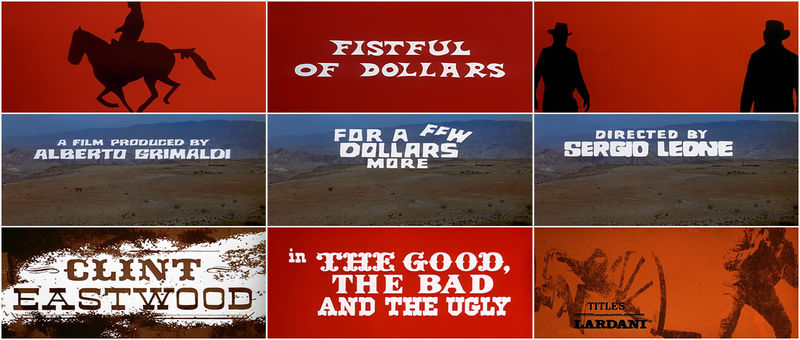You'll need patience and experience (and that rather expensive Adobe subscription), but The Creators Project's tutorial looks like a good way to learn the techniques used to create animations like this. [via Metafilter]![]()
Leo Bazán
Shared posts
How to make 2.5D parallax animations
Hong Kong movie pioneer Run Run Shaw dies at 106
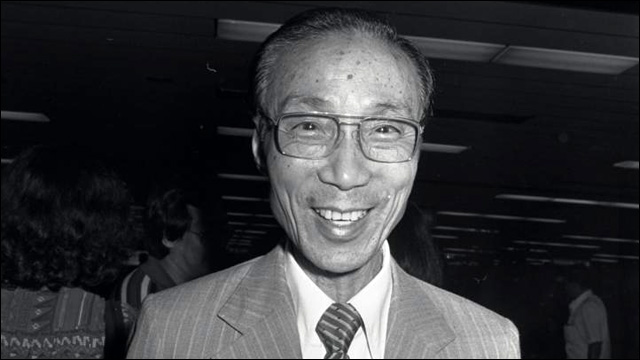
Legendary and prolific movie producer Run Run Shaw, who co-founded the iconic Shaw Brothers film studios, helped bring Chinese martial arts films to an international audience and jumpstarted the careers of countless screen stars, died in his home in Hong Kong on Tuesday. He made it to the badass age of 106.
HK movie mogul Run Run Shaw has died at age 107
Shaw is nothing short of cinematic pioneer, credited with popularizing the kung fu genre. Shaw Brothers studios, founded with his elder brother Run Me in 1958, helped launch the careers of dozens of powerhouse directors and star actors, and produced nearly a thousand movies. Produced under assembly-line conditions, Shaw films weren't always the highest quality flicks, but they made an impact -- and a lot of money.
Read more »
Trenes nipones en el subte de Buenos Aires

Hubo una época en la que fueron libres. Corrían por las vías lejos de la oscuridad de los túneles. Sí, porque los trenes que usamos actualmente en el subte B de Buenos Aires, alguna vez, allá en el tiempo, transportaron a millones de japoneses en sus asientos. El rojo tan característicos de estas formaciones, viene ya de la época en la que se llamaba Línea Marunouchi, la segunda línea de trenes que tuvo Tokio, y la primera que se hizo después de terminar la II Guerra Mundial. Fue un símbolo en su momento de la reconstrucción de Japón.

Inauguradas en los 50, se siguieron utilizando hasta principios de los 90, cuando el municipio de Tokio decidió que era momento de jubilar a los queridos trenes Eidan 300/400/500. Pero el buen estado de conservación y funcionamiento, hizo que en su momento, en 1999, el subte de Buenos Aires decidiera incorporarlos a su flota para formar parte de la línea B de subtes.


Hoy ya es una pieza de museo en Japón. Pero muchos nipones aún se sorprenden cuando visitan Buenos Aires y pueden ver, aún con inscripciones en japonés en algunas de sus paredes y ventanas, a los viejos trenes de la línea Marunouchi de Tokio. Para muchos, un viaje en el tiempo. Para nosotros, uno de los trenes más lindos que tenemos en el subte de Buenos Aires, aún con más de 50 años de antigüedad.

El otro nipón

La otra línea nipona que tiene el subte de Buenos Aires es la línea C. Antes usados en la D hasta la llegada de los trenes Alstom, los Nagoya Serie 250 fueron comprados a esa ciudad también en los 90. Estos trenes también datan de una época similar a la B, pero quizás menos “glamorosos” que los rojos.

Y la novedad es que Subtes de Buenos Aires ya pagó 16 millones de dólares por 5 trenes (30 coches) Nagoya de 30 años de antigüedad (recordemos que los actuales tienen casi 60) para sumarlos a la línea C de subte. Los trenes están siendo reacondicionados en Japón para su entrega en los próximos meses.
The Ziebell projection of the world: 30 people's sketches combined

Zak Ziebell, then a 17-year-old San Antonio senior, challenged 30 people to sketch a map of the world, then combined them into a vague smudge. Then he produced this unnervingly realistic map of the alternative Earth lurking in his subjects' collective memories.
"Just to give an idea of the population sampled, I did this in the summer of 2012 at the University of Michigan Ann Arbor campus," wrote Ziebell, who is planning on majoring in studio art and history, in a thread at Reddit. "Most were 18-22, and there was a roughly even split between male and female. I'm pretty sure they were all American except one Italian guy."
 The scanned and filled-in sketches, superimposed upon one another.
The scanned and filled-in sketches, superimposed upon one another.
Added the high-schooler: "Before anyone calls me out for participating in my own study, this really wasn't meant to be scientific at all, just a fun side project."
A selection of the original maps, as sketched by the participants, reveals a wide range of skill and knowledge. One includes details such as the Falkland Islands and Lake Victoria. Another is hardly more than two shapeless blobs.
"Nobody drew East Asia or Italy that well," wrote Ziebell. ![]()
El origen de los carteles psicodélicos de los 60
Con frecuencia en cualquier tipo de escena artística, ya sea musical, literaria, cinematográfica, etc., existe algún personaje desconocido pero sin el cual el desarrollo de dicha escena no habría sido posible o, en todo caso, habría sido radicalmente diferente.
Así es también en el caso de un momento tan importante como el surgimiento del movimiento musical de San Francisco en los años 60, del que surgieron grupos tan importantes como Grateful Dead, The Jefferson Airplane, Janis Joplin, The Eagles, Santana, Frank Zappa, Steve Miller, The Mamas and The Papas, Crosby, Stills, Nash and Young, Taj Mahal y muchos, muchos más. Bill Graham, un berlinés que siendo niño había huido de los horrores de la Segunda Guerra Mundial y cuyo verdadero nombre era Wolfgang Grajonca, fue el responsable de convertir el Auditorio Fillmore de San Francisco en el epicentro de esta movida y en un lugar legendario para la música.
Con sus conciertos, Graham no solo asoció su nombre para siempre a la historia de la música, sino también a la del diseño. Para la creación de los carteles que promocionaban sus eventos echó mano de varios artistas locales a los que dio libertad total y que, gracias a su talento y a la financiación de Graham, revolucionaron el mundo del diseño.
Entre ellos, uno de los más importantes fue Wes Wilson (Sacramento, 1937), considerado el introductor de la psicodelia en la cartelería de conciertos. Su estilo, inspirado en algunos de los maestros del art nouveau como Alphonse Mucha, pero también en otros artistas como Van Gogh, Klimt o Egon Schiele, fue un terremoto en lo que hasta entonces se había entendido como arte publicitario.
Sin embargo, la influencia clave para Wilson llegará al conocer el trabajo del artista vienés Alfred Roller, cuyas tipografías le marcarán la dirección de su arte. Las letras que el californiano incluye en sus obras de esta época comienzan poco a poco a fundirse de formas tan complejas que pronto su lectura será casi imposible, llenando todo el espacio disponible en el póster, con las líneas fundiéndose entre sí, formando figuras, contraponiendo colores opuestos… En fin, habían nacido los carteles psicodélicos.
Paradójicamente, la calidad y el éxito de estos carteles precipitaron su fin, ya que debido a que estos comenzaron a venderse de forma masiva independientemente de los conciertos, surgieron ciertas discrepancias económicas entre Wilson y Graham que llevaron a que la colaboración se terminara.
Fue entonces el turno de otros artistas como Rick Griffin, Lee Conklin, Grey Irons, Randy Tuten, David Singer y algunos otros que popularizaron y llevaron todavía más allá la estética de finales de los 60.
Aunque la serie de carteles de Bill Graham se termina en 1971, tras el cierre del Auditorio Fillmore de San Francisco y del Fillmore East que Graham había abierto en Nueva York, su legado continua absolutamente vigente y los originales de estos posters, algunos impresos en papel de muy baja calidad, son hoy en día tesoros para algunos coleccionistas que pagan miles de dólares por ellos.
Todas las imágenes son propiedad © de Wolfgang’s Vault. Todos los derechos reservados.
The post El origen de los carteles psicodélicos de los 60 appeared first on Yorokobu.
Iron Maiden makes millions by touring countries where their music is most pirated

Iron Maiden hired a BitTorrent analytics company called Musicmetric to determine where piracy of their music was highest, then scheduled tours of those countries. They made millions touring Central and South America. Iron Maiden LLP has outperformed the UK music sector as a whole and was named one of the "1000 Companies That Inspire Britain" by the London Stock Exchange.
"Having an accurate real time snapshop of key data streams is all about helping inform people's decision making. If you know what drives engagement you can maximize the value of your fan base. Artists could say ‘we're getting pirated here, let's do something about it’, or ‘we're popular here, let's play a show’," said Gregory Mead, CEO and co-founder of the London-based firm.
In the case of Iron Maiden, still a top-drawing band in the U.S. and Europe after thirty years, it noted a surge in traffic in South America. Also, it saw that Brazil, Venezuela, Mexico, Columbia, and Chile were among the top 10 countries with the most Iron Maiden Twitter followers. There was also a huge amount of BitTorrent traffic in South America, particularly in Brazil.
Rather than send in the lawyers, Maiden sent itself in. The band has focused extensively on South American tours in recent years, one of which was filmed for the documentary "Flight 666." After all, fans can't download a concert or t-shirts. The result was massive sellouts. The São Paolo show alone grossed £1.58 million (US$2.58 million) alone.
How Iron Maiden found its worst music pirates -- then went and played for them [Andy Patrizio/Cite World]
(Image: Estadio Saprissa Iron Maiden, a Creative Commons Attribution (2.0) image from adels's photostream)![]()
Science of the perfect chocolate-chip cookie

J. Kenji Lopez-Alt, chief creative officer for Serious Eats, delved very, very deep into the science of making the perfect chocolate chip cookie. He's got a very specific definition of "perfect" ("...Barely crisp around the edges with a buttery, toffee-like crunch that transitions into a chewy, moist center that bends like caramel, rich with butter and big pockets of melted chocolate... with crackly, craggy tops and the complex aroma of butterscotch...that elusive perfect balance between sweet and salty").
But the food science in his piece is deep and fascinating, and provides a kind of road-map for any definition of cookie-perfection. If you've ever wondered about the chemistry of eggs, sugars, flours, rising agents and butter, and how they interact with mixing, cooking, "resting" and cooling, this is pretty much the ultimate, definitive guide thereto. I also defy you to read this without developing a craving for chocolate chip cookies.
The beauty of understanding how ingredients interact with each other is that even if my definition of the "best" chocolate cookie isn't in line with yours, if you've come along this far, then you know what you need to do to adjust my recipe to suit your own tastes. Like your cookies chewier? Substitute some of that all-purpose flour for bread flour. Want your cookies to rise up a little taller? Add a touch of baking powder or replace the yolk of one of those eggs with an extra white. You like your chocolate in distinct pockets? Just use chocolate chips instead of hand-chopped. Want your cookies more flexible and chewy? Just replace some sugar with a touch of corn syrup.
The Food Lab: The Science of the Best Chocolate Chip Cookies (via Kottke) ![]()
60+ Free Mini Icon Sets for Designers
The demand for good icons are too much in these days and finding the best icon sets is not that easy. Being a successful creative web artist has a lot to do with the way you work. Sure, you can’t teach good design in some lessons or you can’t create icons for your daily needs, but it never hurts to pick a few free icons which are always available free to grub.
Designers loves all kind of icons that can help them to covert their imagination into design. And inspire them more and more everyday and give them ideas and directions to design more beautiful and attractive creative works. This list contains some of the best handpicked Free Useful Mini Icon Sets.
Free Mini Icon Sets
Below, you’ll find some of the best free icon sets around for your design enhancement related needs.
80 Mini Icons (PSD + Icon Font)
Application Icon Set (PNG, PSD, CSH)
You should checkout following too.
- Free Icon Sets for Web Designers and Developers – PART 1
- Free Icon Sets for Web Designers and Developers – PART 2
- 60 Free Icon Sets for Christmas Spirit
- “SocialShift” Icon Set: 246 Free Social Networking Icons
Find Something Missing?
While compiling this list, it’s always a possibility that we missed some other great free mini icon sets. Feel free to share it with us.
Visit InstantShift
Australian man travels to Thailand to track down his scammers
Keith Jones was scammed out of US$110,000 by a fraudulent investment firm. Not surprisingly, law enforcement initially had little interest in the case, so Mr. Jones decided to track down the criminals on his own, leading him from his home in Australia to Thailand. He made this high-quality and fascinating documentary of his sleuthing.
HSBC bank, which gave the scammers an account to rip off Mr. Jones, also refused to help him. (That's not surprising either, once you read Matt Taibbi's Rolling Stone article, "Gangster Bankers: Too Big to Jail How HSBC hooked up with drug traffickers and terrorists. And got away with it.")
Above, an update to Jones' story. Unfortunately, the criminals are still at large.
This story is one of deceit, theft, police incompetence, international loopholes and the apathy of a major corporate bank. It is also his story of how almost entirely on his own he tracked down a sophisticated gang of fraudsters.
This is his second time in Bangkok in two years, and exactly as before, he’d rather not be there, but unfortunately, sometimes, there are things that you just have to do whether you like it or not. He’s about to board an overnight train to Chiang Mai, a 14 hour journey to the north of Thailand. He’s making this film as a record of the atrocious and ridiculous events that have lead him to this point. He’s also making it as some sort of catharsis. Finally, he’s making it as a stark warning to others.
Life can be strange sometimes. One minute, you can be travelling along thinking that everything is okay, and almost out of nowhere, the malicious actions of another person can affect your life forever. His story begins back in Australia. He was working from his office one day, when the phone rang. It was the company calling themselves Humphrey Capital Investments, a global financial services group with offices in California and Singapore. Over the coming weeks, he had several informal conversations with their senior portfolio manager John Thompson. One of his recommendations was to invest in Nokia shares. This seemed to present a good buying opportunity.
Humphrey Capital Group sent him client forms, and after processing his application, they bought Nokia shares on his behalf. He subsequently paid the invoice by bank transfer to their company account at an HSBC bank in Hong Kong. Over the coming weeks, John Thompson rang him several times to discuss his portfolio, but at the end of the month, he rang to tell him that his company had been bought out by a group called Wellnic Investments. His new advisor would be Edward Martin, the Vice Chairman of Wellnic Investments. Wellnic’s credentials looked similarly impressive, and their website showed detailed information on the company.
A few days later, he had a call from Edward Martin, and like his predecessor, Edward had an American accent and came over as professional and friendly. He explained that he’d be his new advisor, and he looked forward to a long and profitable relationship, and that’s exactly how it turned out to be. Over a very long period, Keith Jones purchased a variety of low-risk US stocks, trusts and deposits. All trades were paid for through account at a HSBC Bank in Hong Kong.
Subsequently, like the proverbial lamb to the slaughter, he continued to make investments through the Wellnic Group. Within 12 months, he’d invested over $110,000 US dollars. Even saying it now makes him feel quite sick. You often hear that people are scammed through greed, and where unrealistic returns are involved, but most of his investments with Wellnic were supposed to pay around 10 to 12 percent per annum; good, but at the time, not unrealistic. In fact, it was only when things started to sound too good to be true that he became suspicious.
Tyler Capps: Boing Boing Wake Up Cake recipe!
ADVERTISEMENT

Tyler Capps is a chef from the Internet. His 2AM Chili recipe blew up on Reddit back in 2011. Then his comical recipe comic for The Bananarama did too. So Tyler launched Cooking Comically where he posts illustrated HOWTOs for Hobo Pies, Trustfall Chicken, Happy Little Hash Browns, and dozens of other noms. Tyler has just published an excellent new cookbook too, titled, what else, "Cooking Comically: Recipes So Easy You'll Actually Make Them." When we asked Tyler to create a recipe for Boing Boing, our only request was that he base it on one key ingredient, caffeine. That was enough stimulation for Tyler to come up with a magical formula for… Wake Up Cake! Here's the recipe:



For more on Tyler Capps, check out this video:
This post was brought to you by American Express®. Tyler is just one Member of the American Express PassionProject. See all of the inspiring stories here.
![]()
TED: Peter Doolittle: How your "working memory" makes sense of the world - Peter Doolittle (2013)
Your brain is all squishy: An anatomical demonstration
This video was made by the University of Utah Brain Institute to teach medical students about what a brain looks and feels like before it gets preserved in formalin and takes on the texture of a hard rubber ball.
The big takeaway message: Your brain is seriously squishy. So squishy, in fact, that a finger can dent it. As professor Suzanne Stensaas explains, this is one of the reasons why cerebrospinal fluid is so important. Your brain has to float in that fluid. If it didn't, it would come to rest against the side of your hard skull and quickly end up deformed.
Seriously, this is a fascinating (if extremely graphic) video. (Hilariously, given that fact, it opens with an image of a student eating.) Definitely worth watching!
Car goes off bridge into water, occupants don't seem to mind
Driver: Oh, we float.
Passenger: Where are we going?
Driver: I don’t know. Maybe to the shore.
Passenger: Don’t turn the wheel, it’s useless.
(Via 22 Words)
Make a Computer Monitor That Only You Can See
Explaining why dragnet surveillance is terrible, and why you should rally against it
A spectacular PSA from the Electronic Frontier Foundation calls on Americans to join in a rally against mass surveillance on Oct 26, featuring everyone from Phil Donahue and John Cusak to Molly Crabapple and David Segal, as well as Congressmen like John Conyers, prominent whistleblowers like Daniel Ellsberg, Mark Klein, Thomas Drake, and a many others, making the case for limiting government surveillance. It's a spectacular video, and I'd take it as a personal favor if you'd tell your friends about it and show it around.
A Rally Against Mass Surveillance ![]()
Soho Dives, Soho Divas: Sketching London's burlesque artists
Images: Rian Hughes
I'm sure that, like me, you're wary of unsolicited emails offering strange and seductive promises. But, sometimes, curiosity can get the better of you. That's how adventures usually begin.
This is how I find myself using a large Rowney sketchbook to carve my way through the evening crowds around Piccadilly Circus, following Eros' arrow up to the narrow streets of Soho, London's notorious sleaze quarter. Though now gentrified by hip bars, advertising agencies and fancy restaurants, there still exists the occasional corner that the new broom has missed.
Here is Archer Street's cul-de-sac, where what passed for something else was once snorted off the rear spoiler of a cherry-red Toyota Supra, the only flat surface available; over there the Windmill Theatre, now a tawdry clip joint, where friends from long ago were caught in a tabloid sting that got them suspended from their elite girls' school.
Turn right into Chinatown and Wardour Street, where, situated between the Brain Club and The Wag, I shared a studio above a Chinese bakery with a group of comic artist and illustrator friends: Steve Cook, Kev Hopgood, Pauline Doyle, Kim Dalziel, John Tomlinson, Brian Williamson, Andy Lanning, and Lucy Madison.
It was there, one oppressively hot afternoon, that some intimidating thugs turned up looking for our landlord. He apparently owed these Triad types several tens of thousands of pounds in rent, and they had come to collect. We pleaded honest ignorance, and they eventually left.
When confronted, our "landlord" swore innocence and then, that night, changed the studio's locks. Coming in on Saturday morning to collect material for a Tundra Comics launch, I was faced with a new heavy-duty drillproof steel lock and a note demanding advance rent money in return for the keys. A few calls later, the other studio members and I convened in the Falcon pub opposite.
An ask-no-questions locksmith was quickly found. "It's a drillproof lock", he observed. My hopes evaporated. He opened a large plastic case and pulled out something resembling a pneumatic demolition drill. "Should take me ten minutes." We hired a van and, in relays, during the height of the Saturday rush when we couldn't park outside for more than three minutes without blocking the street back to Leicester Square managed to move all our stuff to a friend's studio in Brixton. I got off lightly -- the "landlord" had just taken my airbrush and the cover for Fantagraphics' Dare 1. Kev Hopgood lost an entire issue of Iron Man pencils. If you see these for sale on eBay, please pass on the details. The Triad might want to take a professional interest.
Now, heading further north, I pass the discreet unlabeled door of Soho House, a private club that made me a lifetime member in return for a set of drawings of their manorhouse retreat in Kent. Above Shaftsbury Avenue, just off Old Compton Street, I find an entrance under a gold and black awning. A man in a boxy dinner jacket with a neck wider than his forehead sees me approach and, with the uncanny sixth street-sense all bouncers seem to possess, decides I don't look like trouble. It's probably the sketchbook. A red silk rope is lifted and a paneled Victorian door that has been repainted so many times it no longer properly fits its frame is held open.
Once inside the tiny lobby, I part a heavy velvet drape and enter a dimly-lit bar. Candles dance in dimpled red glass holders on darkly polished tabletops. A pinch-cheeked barman from some distant and underdeveloped country is polishing glasses by the cadaverous light of a glass-fronted refrigerator. "Is this the right place for the life drawing?" I ask, trying to sound like I know what I'm talking about. He stops what he's doing, raises his eyes to look at me, then, with an absolute economy of motion, imperceptibly shifts his head back towards the function room at the rear. I thank him and press on.
I pass small knots of people with their heads bent together conspiratorially, entwined couples on leather settees whose arms are worn through to the coarse fabric musculature underneath. The wood panelling and heavy gilt-framed mirrors give way to a shabbier, loucher decor. To the left is a pair of unpainted chipboard saloon doors with a handwritten sign taped to them. This is it.
I'm late, and the class has already started. In a solo spotlight, on an ornate cast-iron stool, sits a burlesque dancer dressed (barely) in vintage, tasseled and feathered and frozen in an angular dancer's pose. Around her attentively sit a ring of silent acolytes, bent in supplication over the drawing boards propped on their knees or the edge of a barstool. I find a space, and set out my materials. The girl next to me is drawing with one finger on her iPad, but there's no pixels for me here, not tonight -- just the nostalgic analogue art-school mess of graphite, brush and Indian ink. It's as if I'm a student again.
The other attendees, I discover, are illustrators, artists and hobbyists, many drawn from Soho's local animation and special effects houses, and their work turns out to be of a very high standard indeed.
Intermittently attending over a couple of years, I accumulate several hundred drawings, and eventually decide to scan them, clean them up and produce, via the wonders of online digital print, a small black-and-white book. This sells a few dozen copies, mainly to friends in illustration and comics. Image's Eric Stevenson eventually sees a copy, and very kindly offers to publish it. Now with the option of color, I revisit some of the drawings and develop others into finished digital illustrations in Illustrator or Photoshop. Here they are.
I hope I don't physically resemble Toulouse Lautrec, but like him, and more by accident than by design, I've produced a particular record of London's burlesque scene, frozen — just like that model — in a timeless vintage now.
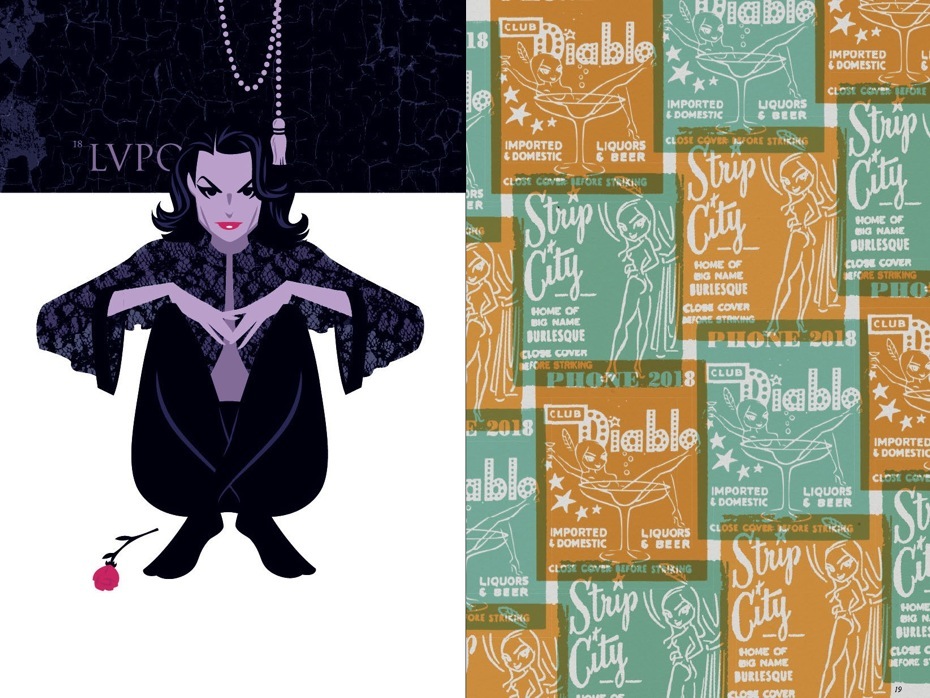
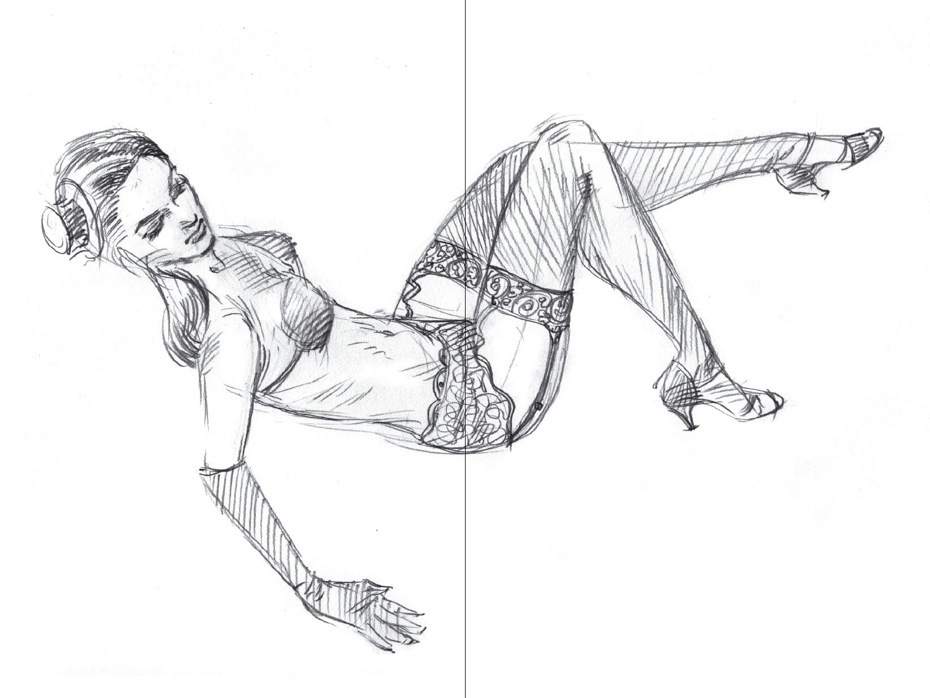

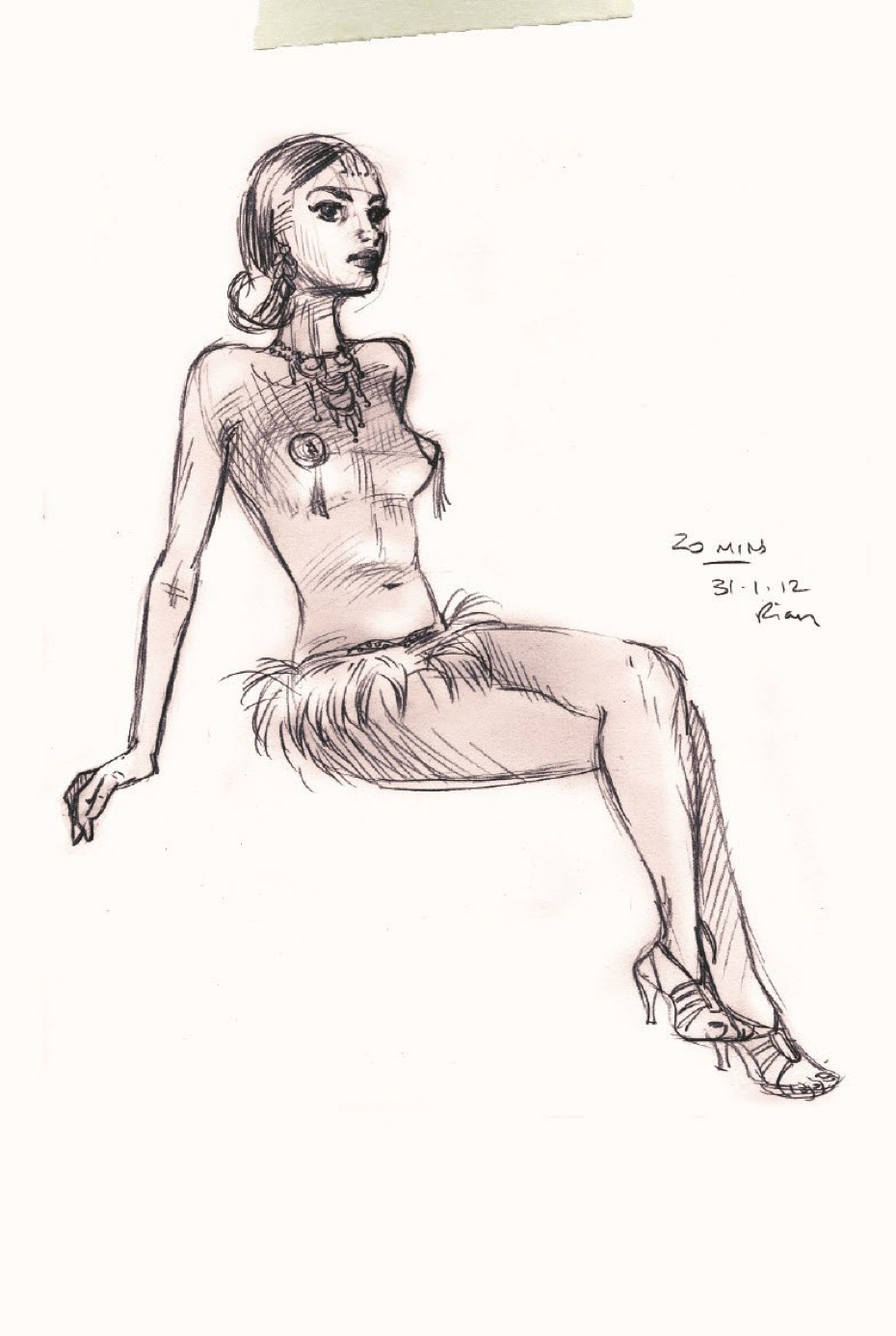
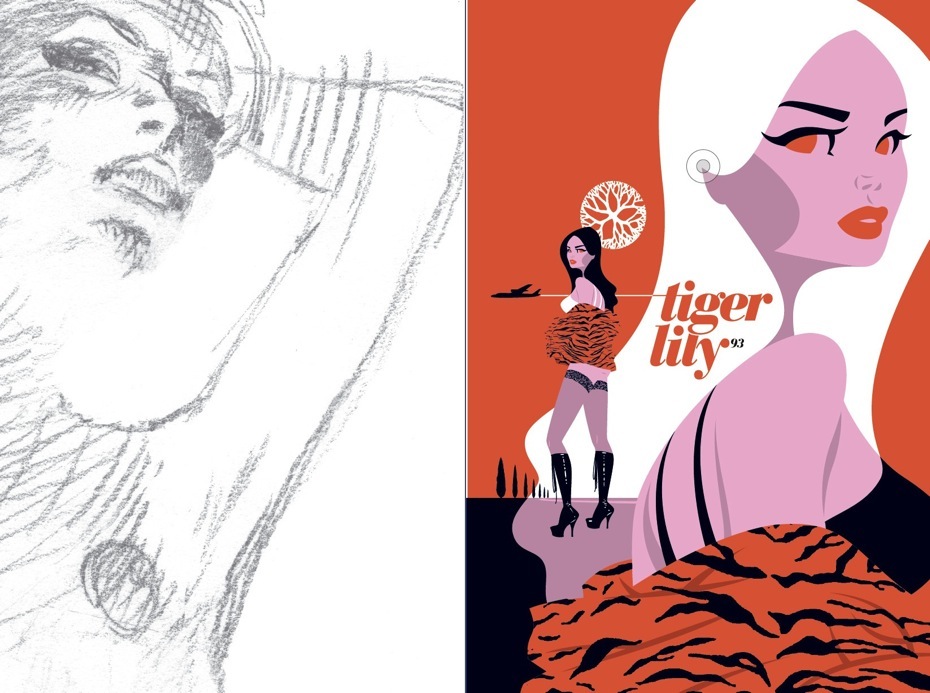


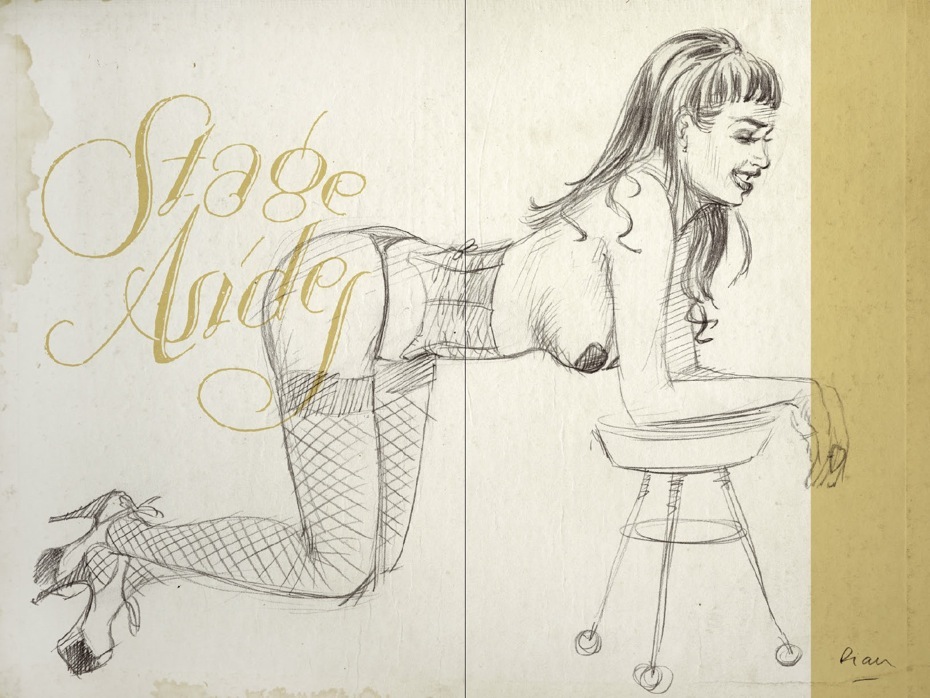
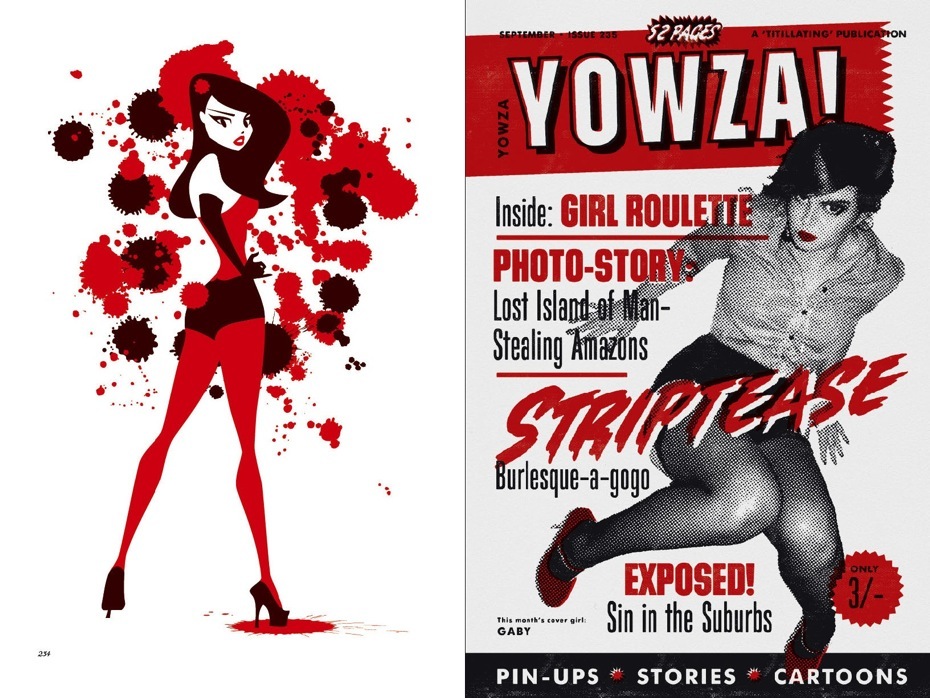

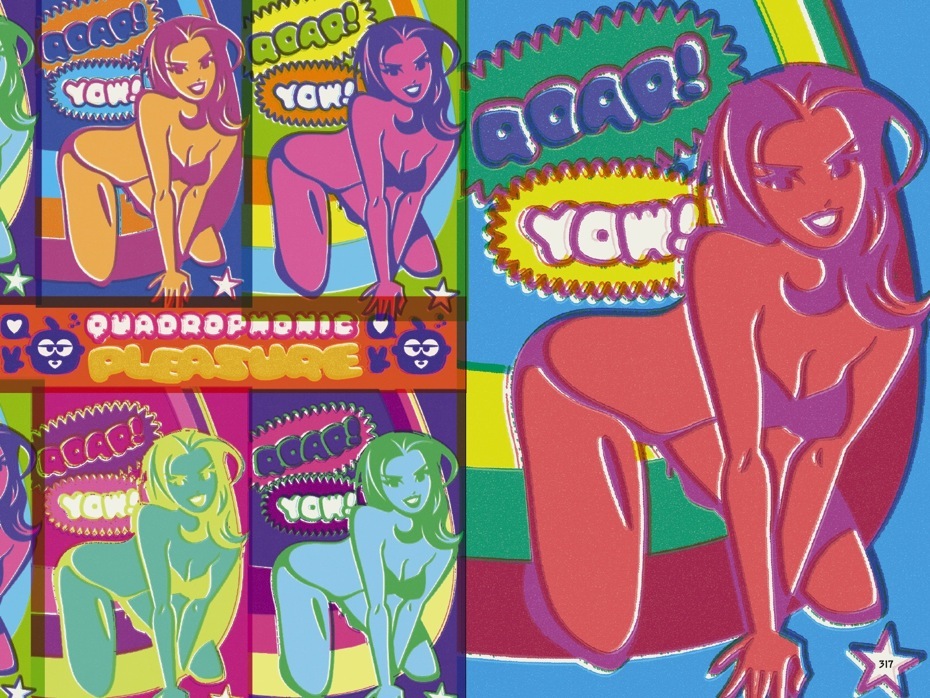
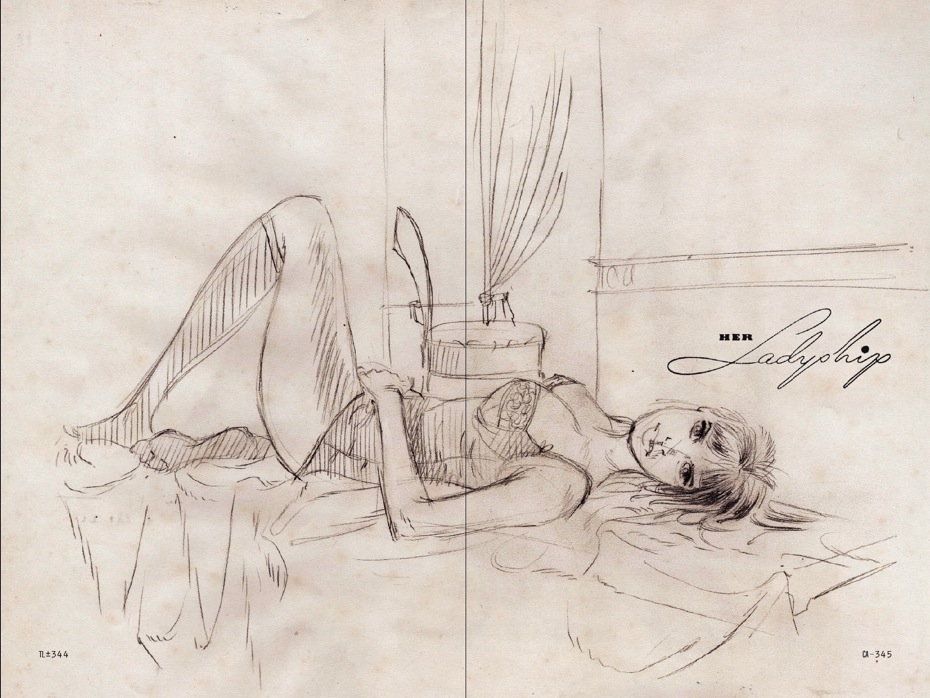
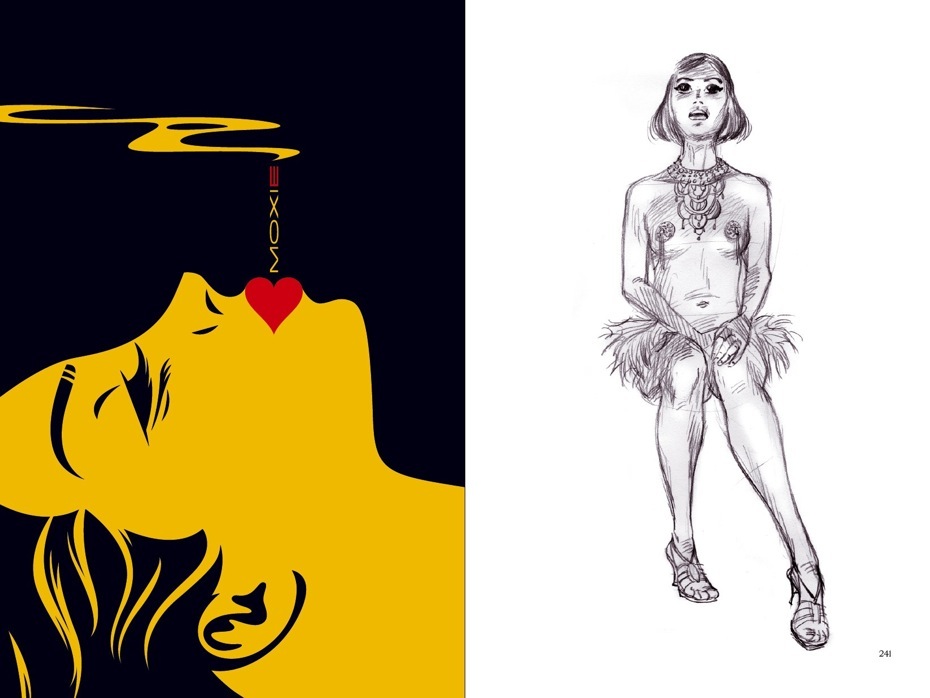
El hombre que solo coge el tren
“Rara vez he escuchado pasar un tren sin desear ir en él”, dijo una vez Paul Theroux. El escritor se recorrió medio mundo subido a uno. Viajó de Londres a Japón por toda Asia, y también la vuelta, en el transiberiano, una experiencia que inmortalizó en su libro The Great Railway Bazaar. Para él siempre será un medio de transporte sin igual para descubrir nuevos lugares. En cambio, cuando el estadounidense se disponía a coger un avión para realizar las otras tantas aventuras que ha hecho a lo largo de su vida, era todo menos complaciente. “Defines un buen vuelo con negativos: no te secuestraron el avión, no te chocaste, no vomitaste, no llegaste tarde, no te produjo nauseas la comida. Así que estás agradecido”.
 Mark Smith no tiene las dotes literarias de Theroux pero va camino de convertirse en uno de los mayores defensores del tren para moverse por el mundo. Este británico es el fundador de la web The Man in Seat 61 que, con un millón de visitas mensuales, es quizá la guía más completa para planificar viajes internacionales por ferrocarril.
Mark Smith no tiene las dotes literarias de Theroux pero va camino de convertirse en uno de los mayores defensores del tren para moverse por el mundo. Este británico es el fundador de la web The Man in Seat 61 que, con un millón de visitas mensuales, es quizá la guía más completa para planificar viajes internacionales por ferrocarril.
El hecho de que Smith nunca pise un aeropuerto no le ha robado la oportunidad de visitar medio planeta. Partiendo desde Londres ha podido conocer casi toda Europa occidental, Europa del Este, Albania, Túnez y Marrakech (con ayuda de un ferri), Ucrania, Siria, Jordania, Rusia y Japón (con la asistencia del transiberiano y un barco). La única vez que hizo trampa en los últimos años ha sido cuando fue a Vietnam. “Confieso que me desplacé en avión, pero una vez allí solo me movía en tren”, dice el británico.
Cuando desea visitar Estambul, ni se le pasa por la cabeza revisar una web de reserva de vuelos. Acude a su estación más cercana para coger el próximo tren y llegar cuatro días más tarde a la ciudad turca. Un trayecto que explica detalladamente en su web y que tiene múltiples opciones de ruta por Viena y Bucarest o cruzando los Balcanes y Bulgaria.
Si, en cambio, prefiere el norte de África, se dirige a Waterloo Station, coge el tren a Portsmouth y sube a un ferri con camarote que en 24 horas le deja en Santander. Una vez en la ciudad cántabra, camina diez minutos hasta llegar a la estación de trenes en donde se sube a un Alvia con destino a Madrid. En Atocha cambia de vía rumbo a Algeciras y en el puerto andaluz se sube en el ferri que finaliza su trayecto en Tánger.
Para las personas acostumbradas a la rapidez del transporte aéreo, probablemente les parecerá un proceso demasiado largo y costoso. Una pérdida de tiempo si no fuera porque Smith considera todo esto parte del viaje en el que siempre se reserva la posibilidad de hacer paradas en los distintos puntos del trayecto. “No lo considero un trámite, como cuando te subes en un avión de Ryanair: intentas ignorar lo que pasa a tu alrededor y deseas llegar a tu destino cuanto antes. Se trata de disfrutar del trayecto. No tienes que hacer colas ni pasar por controles de seguridad. Con una copa de vino en la mano puedes mirar por la ventana y contemplar los cambios de paisaje sin caer en una experiencia estandarizada, como los aviones, en los que casi todo es igual. Es una forma elegante de desplazarse sin ningún tipo de estrés”, defiende.
En un mundo en el que el tiempo está cada vez más comprimido y una población europea con un poder adquisitivo diezmado por años de crisis, hay alguna que otra crítica al discurso de Smith por defender un alegato interpretado como elitista. Opiniones que él refuta. “Cada vez que salgo en los medios británicos recibo casi exclusivamente mensajes positivos. Es curioso cómo en el pasado lo glamuroso era coger un avión y ahora es todo lo contrario. Siempre digo que Michael O’Leary es el mejor amigo de mi causa. La experiencia es casi idéntica en cualquier país. No hay diferencias culturales, todo está muy occidentalizado y aburrido. “El tren, en cambio”, continúa Smith, “cada vez tiene más atractivo. El factor económico tampoco es tan diferente si reservas con tiempo. La industria ferroviaria ha copiado el sistema de precios de las aerolíneas de bajo coste y puedes conseguir unos descuentos buenísimos. En los trayectos nocturnos un billete puede costarte menos que una noche de hotel”.
“Igualmente, si tienes que esperar más para conseguir lo que deseas, acabas apreciándolo mayormente. Tampoco se pierde tanto tiempo”, defiende Smith. “Puedo desayunar en Londres, comer en París y llegar a la hora de cenar a Turín en tren de alta velocidad. Hace poco salí de Suiza a las 4 de la tarde, llegué a París a las 7.30 y el viaje terminó en Londres a las 10.30 de la noche. Si tienes en cuenta los trayectos de ida y vuelta al aeropuerto, los controles de seguridad y posibles retrasos, estamos hablando de una diferencia pequeña con el añadido de que estás viajando en plena libertad”.
Viaje a las islas Wight
Desde que tiene uso de razón, el tren siempre ha sido un lugar evocador para Mark Smith. Con 13 años recién cumplidos, se pasó un mes ahorrando la paga semanal que le pasaban religiosamente sus padres para trazar un plan que llevaba tiempo dibujando en su cabeza. La ocasión se presentó cuando sus progenitores le dejaron viajar solo en tren para ir a visitar a su abuela partiendo desde el centro de Londres. En lugar de ir al destino acordado con ellos, “decidí ir un poco más lejos”, y se compró un billete de ida y vuelta a la isla de Wight, uno de los puntos más al sur de Inglaterra.
 El disgusto de su familia, tras rescatarlo sano y salvo ese día, no apaciguó la fascinación que sintió durante ese primer viaje en solitario. Fue solo el comienzo de un idilio con este medio de transporte que lo llevaría a ser director de la estación de Charing Cross, London Bridge y Cannon Street en los años 90, algunos de los nodos ferroviarios con más afluencia de tráfico en todo Londres, y más adelante directivo en el departamento de transportes británico.
El disgusto de su familia, tras rescatarlo sano y salvo ese día, no apaciguó la fascinación que sintió durante ese primer viaje en solitario. Fue solo el comienzo de un idilio con este medio de transporte que lo llevaría a ser director de la estación de Charing Cross, London Bridge y Cannon Street en los años 90, algunos de los nodos ferroviarios con más afluencia de tráfico en todo Londres, y más adelante directivo en el departamento de transportes británico.
Smith era asiduo al tren no solo para los viajes dentro de las fronteras británicas, sino también para desplazarse fuera de su país aprovechando el túnel excavado en los fondos del canal de la Mancha. Pero su forma de viajar, relativamente minoritaria, requería mucha preparación previa para lidiar con los múltiples organismos ferroviarios que hacían falta contactar para poder organizar unas vacaciones transcontinentales.
Un día hojeando libros en el quiosco WH Smith se encontró con uno que cambiaría su vida para siempre. Era una guía sencilla para aprender nociones básicas de programación que le costó apenas 3 libras esterlinas. “Es probablemente el dinero mejor invertido de mi vida”, dice Smith hablando sobre lo ocurrido en 2001.
Con esa guía empezó a construir los cimientos de The Man in Seat 61 en el que intenta facilitar la realización de estos viajes. “Lo que suelo decir es que volar en una aerolínea low cost es una pesadilla muy fácil de reservar mientras que desplazarse en tren es maravilloso, pero muy complicado de organizar”.
La industria de las reservas de vuelos ha evolucionado hasta tal punto que hace casi obsoleto el modelo tradicional de agencia de viajes. Reservar un vuelo interno en China es casi tan fácil como comprar un billete de avión entre Madrid y Barcelona. Esta usabilidad no se traduce a la reserva de billetes de tren internacionales. Un problema que Smith, asiduo de este tipo de rutas, se ha encontrado desde que tiene uso de razón. Cuando decide viajar a Estambul en tren desde Londres se encuentra que tiene que lidiar con múltiples organismos estatales y páginas webs. “Tampoco ayuda la Unión Europea que, en vez de buscar la unión de las redes, fomenta la competencia”.
A partir de 2007, el inglés decidió dejar su trabajo en la industria ferroviaria para dedicarse al cien por cien a la web, que se ha convertido en su proyecto vital. “La llamé Man in Seat 61 porque es el asiento que siempre reservo cuando viajo en el Eurostar entre París y Milán”. La página se mantiene con publicidad y Smith se encarga personalmente de contestar todos los emails que le llegan cada día. “Intento facilitar y aclarar dudas a cualquiera que me pida información para planificar un viaje”.
Cada cierto tiempo, Smith edita vídeos en los que relata rutas específicas. Secuencias sencillas con texto corrido en el que nunca se cansa de evangelizar sobre la belleza y magia de los viajes ferroviarios. “Sin controles de pasaporte, ni colas para entrar al tren”, enfatiza en su vídeo del viaje entre Londres y París que lleva ya más de 200.000 visitas.
Los trayectos que más interés suscitan a su público (mayoritariamente británico) son Italia y luego España. “Hay mucha gente que busca llegar a estos países de otra forma y convertir el itinerario en parte de la experiencia de sus vacaciones. Además, se está abriendo mucho el tipo de público. Ya no son solo personas con miedo a volar o problemas médicos que les impiden subir a un avión. Empieza a haber una pequeña legión de personas que lo prefieren y otros que lo hacen por razones ecológicas”.
A Smith le divierte mandar dardos a la industria de la aviación y, aunque tiene complicado doblegar una industria tan competitiva y consolidada, “espero que más gente tenga en cuenta el ferrocarril a la hora de irse de vacaciones”. Si no lo consigue con argumentos racionales, tiene recursos emocionales que, según él, jamás tendrán los aviones. “Nunca olvidaré ese viaje que hice a Aleppo en 1995. Partiendo desde Turquía acabé en la cabina de los maquinistas entablando una maravillosa conversación con un hombre que se llamaba Abdullah. Me pedía perdón por el estado de las vías que le impedían superar los 50 kilómetros por hora en muchos trayectos. Nos contamos nuestras vidas y hablamos largo y tendido sobre los trenes. Era el único occidental en un país extraño y lejano. Un viaje que me hizo salir de la burbuja turística. ¿En qué otro medio de transporte vas a tener una experiencia así”.
Los viajes favoritos de Mark Smith
Con centenares de trayectos largos en tren bajo sus espaldas, Mark Smith ha tenido la oportunidad de probar de todo, incluido un viaje de tres días de Norte a Sur en Vietnam y visitar Teherán partiendo desde Londres una semana antes. Suficiente para saber cuáles son sus favoritos. “Si tuviera que escoger tres, lo tendría muy claro. Me fascina el Benina Express que cruza los alpes suizos antes de finalizar su trayecto en el Norte de Italia. Londres a Fort William en los Highlands es lo más cercano a un viaje en crucero que puedes hacer. El paisaje escocés es sencillamente impresionante. Otro de mis favoritos es el viaje en tren de Chicago a San Francisco operado por Amtrak”.
The post El hombre que solo coge el tren appeared first on Yorokobu.
How to spot good gelato from fifteen feet away
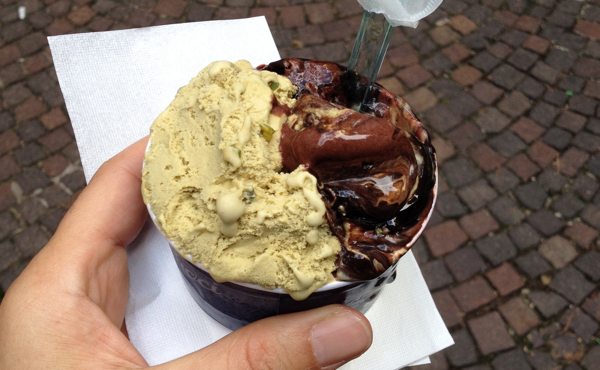 I had the best gelato of my life when I was in Rome the week before last. I bought it at Caffè Tomeucci on Viale Europa. It wasn't too sweet and it had a great texture. The flavors were pistachio and chocolate pistachio. I'll never forget it.
I had the best gelato of my life when I was in Rome the week before last. I bought it at Caffè Tomeucci on Viale Europa. It wasn't too sweet and it had a great texture. The flavors were pistachio and chocolate pistachio. I'll never forget it.
Today I was looking at Tyler Cowan's Marginal Revolution blog, and he linked to an article titled "How To Spot Good Gelato From 15 Feet Away." One thing to look for, says the author, is the color of the gelato:
 If the fruit gelati are made of pure, real fruit then they will be the color that fruit would be if you crushed it: berry flavors a deep dark off-black purple/red, apple white or brownish or yellowish sometimes with flecks of peel, and banana a rather unappealing shade of gray. If, on the other hand, banana is a cheery yellow, apple a perky spring green and berry flavors are the light-ish color of blueberry yogurt, then the gelato before you is a mix of milk with food coloring plus fruit extracts or artificial fruit flavor. Pistachio similarly should be the color of crushed nuts, not bright green… The pistachio on the right here is clearly very artificial.
If the fruit gelati are made of pure, real fruit then they will be the color that fruit would be if you crushed it: berry flavors a deep dark off-black purple/red, apple white or brownish or yellowish sometimes with flecks of peel, and banana a rather unappealing shade of gray. If, on the other hand, banana is a cheery yellow, apple a perky spring green and berry flavors are the light-ish color of blueberry yogurt, then the gelato before you is a mix of milk with food coloring plus fruit extracts or artificial fruit flavor. Pistachio similarly should be the color of crushed nuts, not bright green… The pistachio on the right here is clearly very artificial.
If you want to learn six other ways to spot good gelato from fifteen feet away read the article.
File Under Badass: Malala Yousafzai on The Daily Show

On Tuesday, Comedy Central's The Daily Show welcomed 16-year-old Malala Yousafzai, one of the most badass people to walk this earth, for one the most inspirational television interviews ever.
A year ago, Malala was shot in the head by a gunman after her public fight for the right of girls to get an education put her in the crosshairs of the Pakistani Taliban. But she survived. Today, she is the youngest person ever to be nominated for a Nobel Peace Prize, and her memoir, I Am Malala is out this week.
Like I said, badass. Watch this extended, unedited interview as host Jon Stewart is visibly moved, humbled and at points left speechless by this courageous young woman:
Read more »
A Fistful of Titles: The Westerns of Iginio Lardani
“You see, in this world there's two kinds of people, my friend: Those with loaded guns and those who dig. You dig.” — Blondie
While the myth of the American West may have been forged in the pages of dime store novels and on the screens of Hollywood in the first half of the 20th century, it is three Italians who would define the second: director Sergio Leone, composer Ennio Morricone, and title designer Iginio Lardani. As a team, they triple-handedly defined the Spaghetti Western, which came to supplant its all-American counterpart as due north for the genre.
The Spaghetti Western – so-called due to its low-budget Italian production – is a thrice-removed facsimile of the real thing, passed down through pulp literature via American film adaptation. Its fast and loose approach to both content and structure caricatured the West as a land of larger-than-life heroes and villains ever-drifting through a procession of towns, jail cells, Italo-Mexicans, saloons, and sunsets in search of salvation or revenge, often one and the same.
Director Sergio Leone seemed to understand the Western landscape in his bones, strategically placing both narrative and practical concerns within its borders like pieces on a Cinemascopic chessboard. Morricone's peculiar blend of Western folk, orchestra, avant-garde, and anything else he had laying around gifted the genre a soundtrack like no other. And the…
RSS & Email Subscribers: Check out the full A Fistful of Titles: The Westerns of Iginio Lardani article at Art of the Title.
Comensales por el mundo
Cuando Jay Savsani se acercó a la recepción del hotel en el que se alojaba en Camboya para que le indicasen un lugar en el que pudiera cenar con sus acompañantes aquella noche, no esperaba la recomendación de ningún restaurante de la zona. Por eso, al hacer la pregunta, puntualizó: “¿Podríamos ir a cenar a casa de alguien?”.
Minutos después, Savsani y sus amigos llegaban a casa de Mr Pong. No podían haber conocido mejor anfitrión. Además de compartir mesa con ellos, Mr Pong amenizó la velada con una sesión de música tradicional camboyana, acompañado únicamente por un órgano infantil Casio.
Como la bizarra pero, sobre todo, agradable experiencia no merecía quedar relegada en el capítulo de anécdotas viajeras, Jay la convirtió en una idea de negocio. Sentía la necesidad de que muchos otros Savsani y otros tantos Mr Pong de todo el mundo pudieran compartir mesa, mantel, música y charla de la misma forma que ellos lo hicieron aquella noche.
La start up que Savsani tenía en mente iba a llevar el nombre de Meal Sharing porque lo que trataba era conectar a gente de cualquier rincón del mundo que quisieran probar (como le ocurrió a él en Camboya) o compartir (como en el caso de Mr Pong) su desayuno, comida o cena. “Nos han comparado con el Couchsurfing de la comida casera”, dice Ainara del Valle, eropean lead de Meal Sharing, justo antes de asegurar que desde su lanzamiento en noviembre de 2012, la web del proyecto se ha convertido en la más importante de su categoría, con cerca de 3.000 usuarios en 300 ciudades.
Entre ellos algunos se han dado de alta como Anfitriones (“quieren recibir gente en casa e ir a casa de otras gentes”) o como Invitados (“solo quieren lo último porque no pueden o no quieren compartir sus recetas”). Unos y otros pueden consultar qué anfitriones hay cerca de ellos, consultar su perfil y, sobre todo, el tipo de comida que suelen ofrecer. Una práctica que adquiere aún más significado cuando los usuarios se encuentran de viaje. “Por petición popular, añadimos la posibilidad de ‘invitar’ a otros mealsharers. Al final, compartir una comida con otros es una forma de viajar”.
Meal Sharing aconseja a los invitados que lleven algún detallito, al igual que lo harían al visitar a algún amigo. Antes de eso deben rellenar una solicitud para informar al anfitrión de aspectos como el número de personas que tienen previsto acudir al encuentro, en qué momento del día… A partir de ahí, anfitrión e invitado pueden seguir intercambiando mensajes para concretar otros detalles.
Comer casero a 10.000 km de casa
Mentalidad abierta, ganas de aprender, conectar y sobre todo compartir con los demás son los únicos requisitos que, según Del Valle, se necesita para formar parte de Meal Sharing. “La propia web hace de filtro porque la gente a la que le gusta la idea y decide unirse suelen responder a ese perfil”.
Y subrayamos “únicos” porque no hay ningún otro. “Nos hemos llevado una gran sorpresa porque inicialmente pensamos que los usuarios serían gente joven que está viajando. Pero hay de todo: desde estudiantes a jubilados (¡Nos encanta, porque nadie cocina mejor que una abuela!) de todo tipo de clase y oficio. ¡Hay hasta familias con niños pequeños!”.
Tampoco hay un prototipo de menú ni de tipo de comida. “Está desde el que comparte los cereales del desayuno hasta los que cocinan sofisticadas recetas de la cocina francesa…”. El nivel de habilidad culinaria es lo de menos “porque lo importante no es la comida sino el hecho de compartirla”.
Aunque lo de cocinar platos típicos del país, cuando se recibe a un invitado foráneo, suele ser algo bastante frecuente. Al igual que cocinar alimentos orgánicos: “Muchos anfitriones utilizan productos de sus propios huertos o los huevos de sus patos y gallinas”.
Y como de lo que se trata es de compartir, Meal Sharing siempre anima a sus usuarios a que también lo hagan con su experiencia. Que la documenten en la web con imágenes y detalles de todo lo ocurrido. “Es una forma de hacer más segura la aventura y de ayudar a los nuevos usuarios a que se hagan una idea de lo que es Meal Sharing”.
 Mealshare en una casa barco en Londres
Mealshare en una casa barco en Londres
 Meal Sharing desayuno en Berlín
Meal Sharing desayuno en Berlín
Fotos interior: Meal Sharing
The post Comensales por el mundo appeared first on Yorokobu.
Documentary about four illustrators from Italy
Andrea Chirichelli, a journalist, writer and video-maker, says:
I made a documentary called Illustrators, that describes the job of four Italian illustrators who are world famous and have been awarded many prizes and recognitions: Alessandro “Shout” Gottardo, Emiliano Ponzi, Olimpia Zagnoli, and Francesco Poroli.
The documentary lasts approximately 70 minutes, is subtitled in English, and offers a wide view on the secrets of a new job, that has transformed completely ever since the Internet’s arrival, that has marked a pivotal change in the world of publishing, commercials, and magazines.
Illustrators is a journey of images in the creativity of a nation, Italy, depressed and mortified under the political and economic aspect, but still capable of showing its best side and bound to live, at least under the artistic profile, an outright “Second Renaissance.”
 Alessandro “Shout” Gottardo
Alessandro “Shout” Gottardo 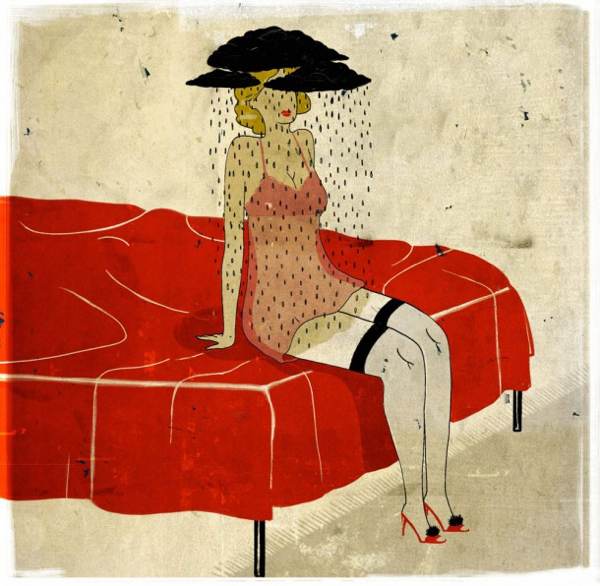 Emiliano Ponzi
Emiliano Ponzi  Olimpia Zagnoli
Olimpia Zagnoli  Francesco Poroli
Francesco Poroli
American dialects mapped

Joshua Katz, at NC State University's Department of Statistics, compiled a series of simple, striking maps that visualize the words Americans use—and where they use them. The data was compiled from a survey conducted by Bert Vaux at the University of Cambridge. Below are just a few to whet your appetite for the full set of 122.










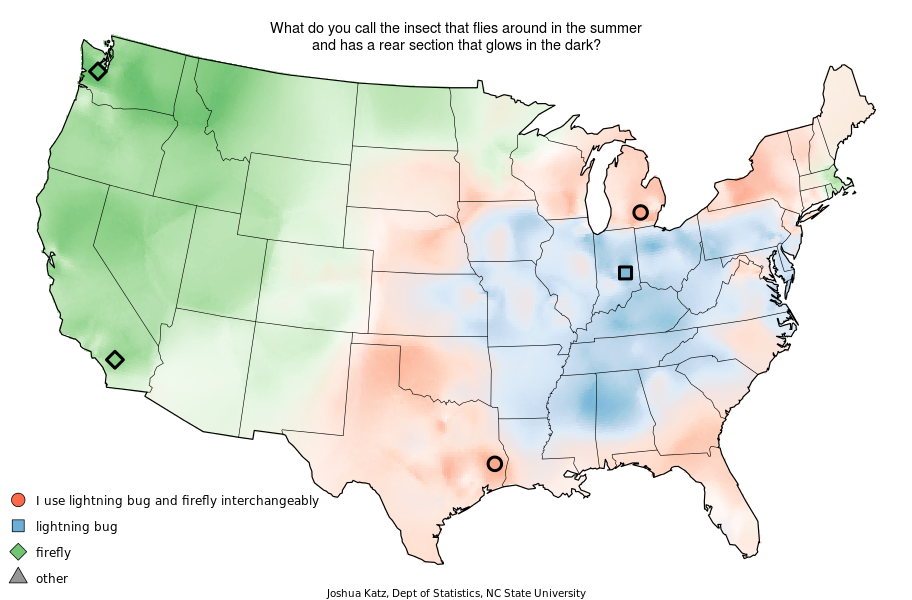

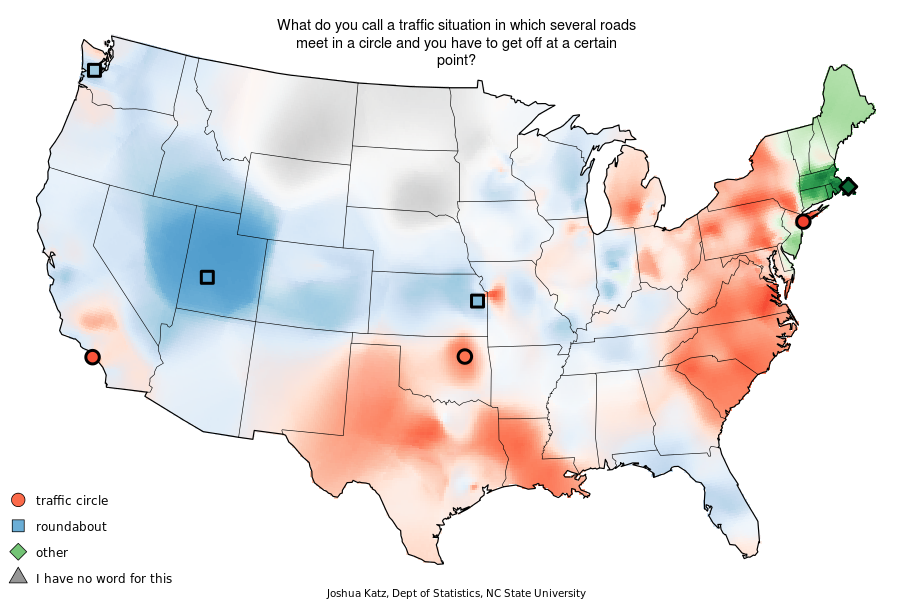



![]()
Fear of clustered small holes

The Trypophobia subreddit is a place for posting photos of things with clusters of small holes or pits in them, like lotus plants, funguses, multi-chambered plants, and strange infections. Trypophobia is the (not medically recognized) fear of "objects with small holes." It sounded weird to me, but after clicking through the first couple-dozen links, I was massively squicked. Shown here, Ethiopian injera bread from Apple Pie, Patis, and Pâté Recipes. Normally, I love the stuff, but in the context, I have to admit, it gives me the frisson.
The most common phobia you've never heard of. (Thanks, Fipi Lele!) ![]()






















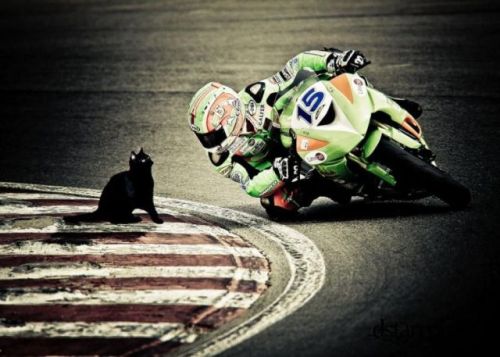

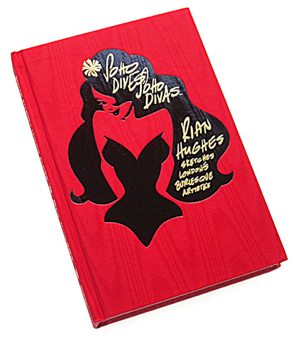 Rian Hughes' Soho Dives, Soho Divas, available from Amazon, is a unique series of portraits of London's underworld burlesque artists. Collected here are stylish and erotic sketches from life, bold graphic illustrations, and beautiful paintings in an eclectic variety of media and styles.
Rian Hughes' Soho Dives, Soho Divas, available from Amazon, is a unique series of portraits of London's underworld burlesque artists. Collected here are stylish and erotic sketches from life, bold graphic illustrations, and beautiful paintings in an eclectic variety of media and styles.


